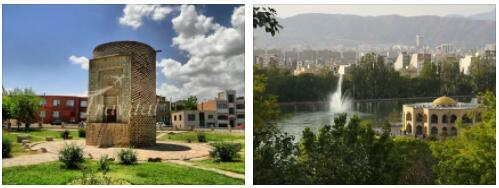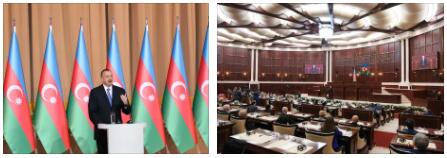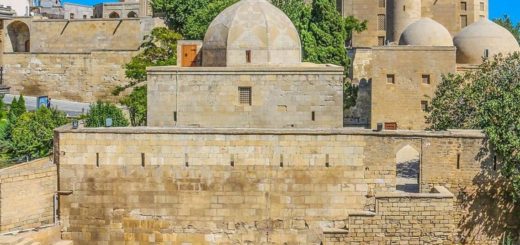Azerbaijan – Persian Provinces
According to Thesciencetutor.org, the region that constitutes today’s Azerbaijan was in antiquity subject more or less directly to the Assyrian empire, and with the decline of this, in the second half of the century. VII a. C., was part of the kingdom of the Medes. Incorporated in the century. VI to the great Persian empire, it was included in the satrapy of Media, until, after the death of Alexander, it was taken over by Atropates, a Persian satrap passed to the Macedonian king, from whom the name of Atropatene originates, with which the region is known to classical writers. The Atropate dynasty remained independent during the entire Hellenistic period; later we find Atropatene in the condition of an autonomous province of the kingdom of the Arsacids, and later still of the province of the kingdom of the Sāsānids. Christianity entered it quite early, introduced by the Syriac missions, and took on, as in the rest of the Persian empire, the form of Nestorianism (there is attested an episcopate starting from the sixth century). From the Persian form of Atropatene, Ā dhurb ā dhag ā n, derives that Ā dharbaigi ā n with which the country is known to Arab geographers and historians: in fact, it soon entered the orbit of Muslim conquests, and was subdued in 22 ègira (643 AD); despite frequent revolts of the Persian population, it remained under the dominion of the Umayyad and Abbasid caliphs, following the fate of Persia, and, like it, was conquered by the Mongols in the century. XIII; then passed under various dynasties of Mongol Īl-Khān and Turcomanni, it returned to a Persian province, under the Ṣafawidi dynasty in the century. XVI (see Persia, history). Its capital, which was initially Ardabīl, was later transported to Tabrīz, where it has remained to this day. The centuries-old infiltrations of Turkish elements from the East have considerably changed the ethnic constitution of the population and introduced a Turkish dialect as the language of use (the so-called ā zeri).
Federal States of USSR. On May 28, 1918 the nationalist party, or Mussavet, of the Constituent Assembly of the Tatars proclaimed the independence of the Republic of Azerbaijan (Azerbajd ž an) with its capital first in Gandža (Elisavetpol), then in Baku, forming, together with the republics Armenia and Georgia, a Caucasian Federation. In April 1920 the Socialist Party, or Kummet, overthrew the government and opened the doors of Baku to Soviet troops. The republic was Soviet reconstituted, a treaty was signed with Russia, and, on December 30, 1922, Azerbaijan was declared a Federal State of the USSR, together with the Soviet republic of Nachichevan and the autonomous territory of the Highlanders (Nagorny Karabach). Azerbaijan borders to N., along the course of the Samur and a stretch of the Caucasus range, with Dagestan; to the West, with Georgia and Armenia; to S., with Persia; to E. is limited by the Caspian Sea. The total area is 85,968 sq km; the population of 2,314,571 residents (1926).
The relief consists of three distinct geomorphological zones: a northern one, consisting of the extreme eastern section of the Caucasus chain, oriented from the NW. to the SE., which from the top of the Bazar Djuza (4489 m.) is increasingly degrading until it is reduced to the small hills of the Apšeron peninsula; a southern one, also mountainous, parallel to the previous one, made up of ancient rocks, such as granites, diorites and porphyries, interspersed with rocks of recent origin, such as trachytes, basalts, pumice and tuffs, and which includes the Šach Dag, Murov Dag chains, the Dali Dag and the Karabach; a central one, consisting of the eastern part of the great Kura valley, with the steppe regions of Širvan, Karabach and Muran, rich in alluvial materials. Between the ranges of the Murov Dag and Karabach mountains, the Karabach plateau develops, sprinkled with ancient extinct volcanoes. To the extreme SE. the Tališ mountains rise, which form the junction with the Elburs chain. The coast develops from the mouth of the Samur, to N., on the border of Persia, to S. of the town of Lenkoran, and offers nothing characteristic outside the peninsula of Apšeron (v.), Which extends for about 60 km up to Cape Sachov, towards E., forming the good Baku Bay; further to S. there is the bay of Kizil-Agač. Off the coast there are some small islands. The climate is rather mild, with average annual and seasonal temperatures equal to the Mediterranean ones. However, local variations, especially in the mountainous region, are very sensitive. Atmospheric precipitations oscillate between 200 and 400 mm., Less than in the SW area, where they increase up to 1000 mm. Snowfalls are frequent in the mountains, but very rare elsewhere. Compared to that of western Transcaucasia, the climate of Azerbaijan is more continental, due to the scarce influence exerted by the Caspian Sea. The hydrography is represented by the lower course of the Kura, starting from the confluence with the Chram at 40 km. about SE. of Tiflis, and from the Arasse starting from the Migri strait. Some rivers, especially those of the northern slope of the Caucasus range, are lost in the marshes of the steppe zone. The vegetation is neither very developed nor very varied, above all due to the scarcity of atmospheric precipitations. We can distinguish some mountainous areas, mainly covered with forests, but not very dense; a steppe zone, which occupies the Karabach plateau and the Kura valley; an area of pastures on the northern slope of the Caucasus. The fauna is also not very abundant, nor as characteristic as that of western Transcaucasia. They are frequent: a species of gazelle, the jackal, the francolin, and the hyena. Among domestic animals, sheep prevail. The population is mainly made up of Turkish-Tatar elements, who settled in the country since the time of the Mongolian conquest; but, under the Persian and Russian influence, they changed considerably. There are still the Talisci of the Lenkoran district; numerous Armenians and a few Georgians and Russians, who live in the cities. 77% of the population lives scattered in the countryside. Azerbaijan is a predominantly agricultural country and the main products are cereals, cotton, wine, vegetables, fruit, tobacco and silk. Pastoralism is highly developed in mountain regions. 75% of the land is arable. Cotton production is around 640,000 quintals. The main mineral product is oil; then come the copper and the salt. Manufacturing industries include oil refineries, fish salting, spinning and weaving. The communication routes include, in addition to the ordinary and caravan routes, the Transcaucasian railway Batum-Baku, Baku-Derbend and Baku-Karalar. Poor inland navigation takes place on the Kura; more active is the maritime for fishing and the export of oil from Baku.
Persian Provinces – It is the northernmost of the Persian provinces, bounded to the north by the course of the Arasse, to the east by the Tališ district – pertaining to Soviet Azerbaijan – and by Gilan, south of Khamse and Ardilan, and to the west by the political border, recently fixed, between Persia, Turkey and Irāq.
The territory, all mountainous, consists of a plateau, high on average over 1500 m., On which the Qara Dagh group rises to the north, continued towards the Caspian by the Tališ mountains, and, along the western border, that series of elevations that form the watershed between the basin of the Tigris and the Euphrates on one side, of the Arasse and the Lake of Urmiyah on the other. To the east of the latter dominate the two volcanic reliefs of Sahend (3545 m.) And Sawalan (4820 m.), The highest peak in Azerbaijan. Its continuation towards the south is the district of Khalkhal, constituting the physical and ethnic limit of the country. The two volcanoes are now extinct, but there are traces of endogenous activity (thermal springs, sulfur springs, etc.) throughout the eastern part of the region, essentially formed by trachytic areas,
In addition to the tributaries of the lake, Azerbaijan is irrigated by numerous, but small and poor, streams. The fertile district of Hasht Rūd sends its waters through the Carangu to the Qizil Uzun, the middle course of which belongs to Azerbaijan. The climate is continental, with dry and harsh winters, and very hot summers. Temperatures naturally vary greatly from place to place. The rainfall is generally scarce (240 mm. Per year) and decreases from east to west.
The population is essentially made up of Turco-Tatars; Kurdish tribes, having abandoned their nomadic habits almost completely, have settled in the southern and western districts; Persians in cities and some areas of the south. Overall, it is estimated that Azerbaijan has around 2,000,000 Shiite Muslim residents, scattered over an area of square kilometers. 105,000. The main occupation is agriculture; the main products are wheat, barley, rice, tobacco, cotton, castor. Rightly renowned are the orchards, flourishing the cultivation of vegetables. The mineral riches (asphalt, bitumen, rock salt, sulfur, copper, coal, oil), although undoubtedly considerable, still represent a potential value. The home-made carpet industry is one of the best in Persia.



